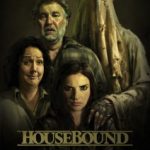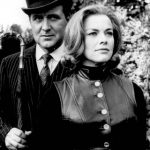{These are not movie reviews per se and may contain spoilers}
 The only time my wife will sit down to a horror movie is Halloween weekend. She selects the fare off of Netflix, and I get to see some suspense/horror that is beyond my normal Cushing/Lee/Price diet. This last Halloween weekend we sat down to Housebound, a 2014 New Zealand horror comedy about a young neer-do-well woman confined to house arrest in her mother's creepy house. There is some detox going on, and the movie has a slow build. At one point our junky herione wakes up to a maniacal sounding Teddy Ruxbin. C
The only time my wife will sit down to a horror movie is Halloween weekend. She selects the fare off of Netflix, and I get to see some suspense/horror that is beyond my normal Cushing/Lee/Price diet. This last Halloween weekend we sat down to Housebound, a 2014 New Zealand horror comedy about a young neer-do-well woman confined to house arrest in her mother's creepy house. There is some detox going on, and the movie has a slow build. At one point our junky herione wakes up to a maniacal sounding Teddy Ruxbin. C reepy, almost interesting, seemed mostly nostalgic. One of her next selections was The Awakening, a 2011 British horror movie set in 1921. The plot is apropos of nothing in this post. However, our heroine breaks into a wall at one point to find a teddy bear that is repeating recorded clues to the mystery. Seemed a little hi-tech for the time period.
reepy, almost interesting, seemed mostly nostalgic. One of her next selections was The Awakening, a 2011 British horror movie set in 1921. The plot is apropos of nothing in this post. However, our heroine breaks into a wall at one point to find a teddy bear that is repeating recorded clues to the mystery. Seemed a little hi-tech for the time period.
So the personal rule for synchronicity is three obscure references within 24 hours from non-related sources.
The two above movies were chosen by someone else and had nothing else in common than being suspense fare on Netflix.
As often happens, my wife fell asleep soon after midnight and I eventually gave in to insomnia and returned to the living r oom. My insomnia watchlist at the time included starting the second season of the 1960s British TV spy show The Avengers. The first episode of the second season the evil genius bad guy talks to our heroes Steed and Gale through, you guessed it, a speaker in a teddy bear.
oom. My insomnia watchlist at the time included starting the second season of the 1960s British TV spy show The Avengers. The first episode of the second season the evil genius bad guy talks to our heroes Steed and Gale through, you guessed it, a speaker in a teddy bear.
When I was 6 weeks old, I was given a stuffed bear with a music box in it. My mother had imaginatively named him Theodore. I was told the music box worked once but since I was never given a straight answer so I assume that it was another victim of my father's violence. Theodore has somehow survived the years and the travels and now lives on a shelf up in the guest room. He's never spoken to me, not even during my craziest days. I don't think looking for a stuffed bear to talk to me is the meaning of the synchronicity.
I just finished The Lovecraft Code by Peter Levenda. His first fiction book, it's a wannabe military thriller with lots of second-rate Cthulhu musings and plot. No surprises, we learn that 'the stars are right' whenever there is a mini-nova in the constellation of the Great Bear. It is also implied that the Old Ones speak to their minions from Ursa Major. Get it, talking bear? Nah, not going for it. It just seems a pale imitation of Robert Anton Wilson's Sirius theory. How many stars are supposed to be talking to us?